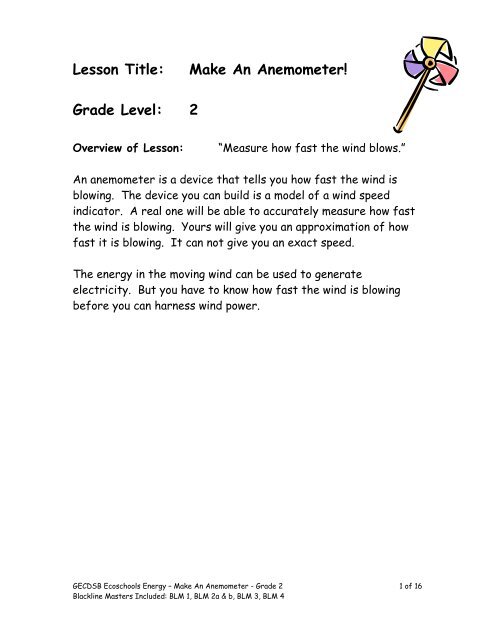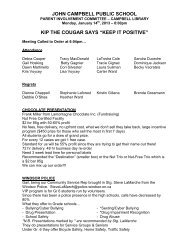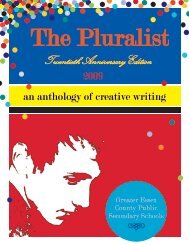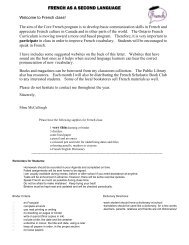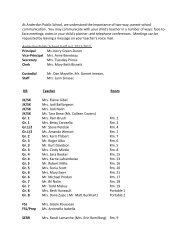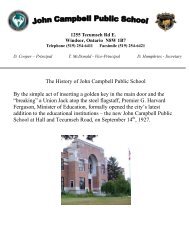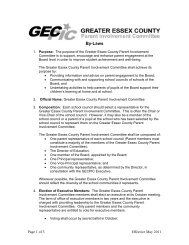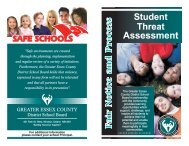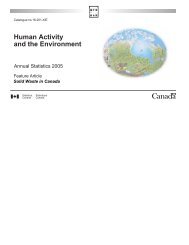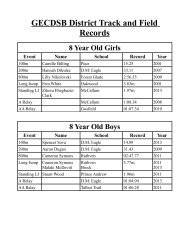Make An Anemometer
Make An Anemometer
Make An Anemometer
You also want an ePaper? Increase the reach of your titles
YUMPU automatically turns print PDFs into web optimized ePapers that Google loves.
Lesson Title:<strong>Make</strong> <strong>An</strong> <strong>An</strong>emometer!Grade Level: 2Overview of Lesson:“Measure how fast the wind blows.”<strong>An</strong> anemometer is a device that tells you how fast the wind isblowing. The device you can build is a model of a wind speedindicator. A real one will be able to accurately measure how fastthe wind is blowing. Yours will give you an approximation of howfast it is blowing. It can not give you an exact speed.The energy in the moving wind can be used to generateelectricity. But you have to know how fast the wind is blowingbefore you can harness wind power.GECDSB Ecoschools Energy – <strong>Make</strong> <strong>An</strong> <strong>An</strong>emometer - Grade 2 1 of 16Blackline Masters Included: BLM 1, BLM 2a & b, BLM 3, BLM 4
Big Ecological Ideas:People can use water and wind power to produce electricity thatis non-polluting.The power of the wind and the water (which comes from the sun’s energy) can be capturedto make things turn. A wheel with turning blades can be attached to machines used to dowork or produce electricity. Canada is also beginning to use wind power to produceelectricity – the Pickering wind turbine near Toronto is one of North America’s largest windturbines. Denmark uses windmills to make over 15% of its electricity in a non-polluting way.There are advantages and challenges to using renewable energy sources such as wind andwater energy.• One advantage to using renewable resources which also includes bio-diesel fuel fromgrains, water energy from waves, heat energy from the earth, than nonrenewableresources such as fossil fuels (e.g., coal, oil, gasoline) is because they do not makemuch pollution.<strong>An</strong>other advantage is that renewable resources are continuously replaced by theearth’s process (e.g., trees are used for wood, grains are used for fuels (ethanol),the sun drives the cycles that make the wind blow and the water evaporate and fallagain).• A disadvantage to using some of the renewable forms of energy (e.g., wind, solar) isthat they are less concentrated than fossil fuels.GECDSB Ecoschools Energy – <strong>Make</strong> <strong>An</strong> <strong>An</strong>emometer - Grade 2 2 of 16Blackline Masters Included: BLM 1, BLM 2a & b, BLM 3, BLM 4
Ontario Curriculum Expectations:Science and Technology: Energy and Control:Energy From Wind and Moving Water2s492s502s512s522s532s542s572s62-demonstrate an understanding of the movement of airand water as sources of energy-design and construct devices that are propelled bymoving air or moving water-identify wind and moving water as renewable sources ofenergy and determine the advantages of using them-identify movement as an outcome of energy input (e.g.,fuel enables cars, trucks, and buses to move, electricityenables the fan in the kitchen to move; food enableshumans to move)-recognize that it is the movement of air and water thatproduces energy and that air and water are not bythemselves sources of energy-identify various ways in which moving water is used as aform of energy (e.g., hydroelectricity, tidal energy)-ask questions about and identify needs and problemsrelated to the use of wind and moving water as energysources, and explore possible answers and solutions (e.g.,describe how moving water is used to produce electricity;describe how windmills were used to grind grain intoflour)-identify devices that use moving air and moving water asenergy sources (e.g., windmills, water wheels). <strong>An</strong>ddescribe what happens to these devices when the air andwater is stillGECDSB Ecoschools Energy – <strong>Make</strong> <strong>An</strong> <strong>An</strong>emometer - Grade 2 3 of 16Blackline Masters Included: BLM 1, BLM 2a & b, BLM 3, BLM 4
Prior Learning:By making and using pinwheels prior to constructing this device,children discover that air can move things. Refer to ScienceEverywhere.Assessment Opportunities:The teacher observes and notes students’ ability to:• assume responsibility in carrying out group tasks• listens to and considers the opinions and ideas of othergroup members• follow directions within the group• how well are children able to plan, construct a model andconduct inquiries• participate in group evaluation and discussions• is willing to take risks• demonstrate perseverance in completing investigations• observe and record relevant ideas in a clear, concise manner• how well the children• can explain cause and effect relationships• report and communicate ideas/interpretations clearly in anaccurate mannerThe teacher may use Blackline Master 1 (BLM 1) “SkillsTracking Sheet” to guide observations.Time Frame:Science block over a period of 3 or 4 daysGECDSB Ecoschools Energy – <strong>Make</strong> <strong>An</strong> <strong>An</strong>emometer - Grade 2 4 of 16Blackline Masters Included: BLM 1, BLM 2a & b, BLM 3, BLM 4
Materials Needed:(per group)• 2 scissors• 4 small paper cups (drinking cups)• 1 marking pen (any colour)• 2 strips of stiff, corrugated cardboard – the samelength• ruler• stapler• 1 push pin• sharpened pencil with eraser on the end• 1 blob of plasticine (1 package divided equally among allgroups)• 1 stopwatch or watch with second handProcedure:Activity One:Small groups (3-4 children) can work together tocreate one anemometer. Children can read andfollow the directions listed on BLM 2a & b.GECDSB Ecoschools Energy – <strong>Make</strong> <strong>An</strong> <strong>An</strong>emometer - Grade 2 5 of 16Blackline Masters Included: BLM 1, BLM 2a & b, BLM 3, BLM 4
1. Cut off the rolled edges of the paper cups to make themlighter.2. Colour the outside of one of the cups with the marking penor use a different coloured cup.3. Cross the cardboard strips so they make a plus sign (+).Staple them together.4. Take the ruler and pencil and draw lines from the outsidecorners of where the cardboard strips come together tothe opposite corners. Where the pencil lines cross will bethe exact middle of the cross.5. Staple the cups to the cardboard strips; make sure the cupsall face the same direction.6. Push the pin through the intersection point of thecardboard (where the pencil lines cross).7. Attach the cardboard cross with the cups on it to theeraser end of the pencil.8. Blow on the cups to make sure the cardboard spins aroundfreely on the pin.Using BLM 2a & b have the children draw and label a diagramof the anemometer they created.GECDSB Ecoschools Energy – <strong>Make</strong> <strong>An</strong> <strong>An</strong>emometer - Grade 2 6 of 16Blackline Masters Included: BLM 1, BLM 2a & b, BLM 3, BLM 4
Activity Two:This activity will take place outdoors. Children can experiment intheir small groups. Provide each child with cardboard clipboards,as well as BLM 3 and 4 for recording.1. Discuss the weather and wind conditions on that particularday.• Record the weather conditions on Day 1 and write yourpredictions on BLM 3 prior to starting your experiment.2. Place the “blob” of plasticine on a surface outside, such as aporch railing, wooden fence rail, a wall or a rock. Stick thesharpened end of the pencil into the plasticine so it standsup straight.3. Using your watch or stopwatch, count the number of timesthe coloured cup spins around in one minute.4. Explain that they are measuring the wind speed inrevolutions (turns) per minute. Weather forecasters’anemometers convert the revolutions per minute intokilometers per hour (or miles per hour).5. Have the children begin the experiment. Someone can countthe revolutions out loud, as another child records the tallyof revolutions on BLM 3.GECDSB Ecoschools Energy – <strong>Make</strong> <strong>An</strong> <strong>An</strong>emometer - Grade 2 7 of 16Blackline Masters Included: BLM 1, BLM 2a & b, BLM 3, BLM 4
Activity Three and Four:1. Same procedure as Activity Two.2. Keep a record of wind speeds you’re measuring for the nexttwo days on the same BLM 3 and 4.• Measure the wind speed at different times of the day• Is it the same in the morning and the afternoon, theevening?• Move your anemometer to another location• Is it windier in other places?• Do trees or buildings block the wind?3. Log your observations and ideas on BLM 3 and 4.Reflections for Students and Teachers:Have groups present their findings and interesting observations,sharing the number of revolutions on certain days.To facilitate discussion, ask questions such as:• What made the anemometer move?• What is wind?• Is the wind speed the same in the morning and afternoon?• Is it windier in other places?• Do trees or buildings block the wind?• Where will the wind blow the hardest and where the winddid not blow at all?• How can you change the direction the anemometer ismoving?• Does your data agree with your prediction of the windconditions?• How is the number of turns in one minute related to thewind conditions?GECDSB Ecoschools Energy – <strong>Make</strong> <strong>An</strong> <strong>An</strong>emometer - Grade 2 8 of 16Blackline Masters Included: BLM 1, BLM 2a & b, BLM 3, BLM 4
Wind Facts:Wind speed is important for wind energy. Wind turbines - whichare the machines that change the movement of wind intoelectricity – need a constant, average wind speed of about 24kilometers per hour (or 14 miles per hours) before the windturbines can generate electricity. That’s why wind farms, wherethere are a lot of wind turbines grouped together, are located inwindy spots.Adaptation and Extension Opportunities:A mom and daughter devised a clever way to measure wind speedin miles per hour. With a slightly different anemometer, thewhole family got into the car. One person drove the car, one heldthe anemometer out of the window – these two were adults –another held the stopwatch, and another counted the revolutionsof the anemometer. They drove exactly 10 miles per hour. Inone minute their anemometer made 100 revolutions. Assumingthere was no wind that day, they determined that with theiranemometer 100 revolutions per minute equals 10 miles per hour.If they wanted to they could verify the accuracy of theirmeasurements by using a real anemometer like the ones used byweather forecasters and airports.Encourage the children to read to find out about different waysof monitoring the direction and speed of the wind.GECDSB Ecoschools Energy – <strong>Make</strong> <strong>An</strong> <strong>An</strong>emometer - Grade 2 9 of 16Blackline Masters Included: BLM 1, BLM 2a & b, BLM 3, BLM 4
Math Extension: for data management• Bar graph the students results from their experiment• Create a long term weather log and graph the results – classposterLiterature Links:• Air is All Around You by Franklyn M. Branley• Amazing Air Air by Henry Smith• Air, Air Everywhere by Tom Johnston• Follow the Wind by Alvin Tresselt• Gilberto and the Wind by Marie Hall Ets• The Wind Blew by Pat HutchinsSuggested Resource Websites:http://www.evergreen.ca/en/lg/lessons/wind-waterloo.pdfhttp://www.utm.edu/departments/cece/old_site/second/2I3.shtmlhttp://www.opg.com/envComm/windturb.pdfReferences:Sources of Lesson Plan:Based on an activity from “Capturing Nature’s Forces – Measuringthe Wind – Building an <strong>An</strong>emometerwww.energyquest.ca.gov/projects/anemometer.htmlGECDSB Ecoschools Energy – <strong>Make</strong> <strong>An</strong> <strong>An</strong>emometer - Grade 2 10 of 16Blackline Masters Included: BLM 1, BLM 2a & b, BLM 3, BLM 4
BLM 1:The teacher observes and notesstudents’ ability to:Skills Tracking SheetChildren’s NamesSkills-assumes responsibility in grouptasks-listen to and considers the opinionsand ideas of other group members-follows directions within the group-how well are children able to plan,construct a model and conductinquiries-participates in group evaluation anddiscussions-is willing to take risks-demonstrates perseverance incompleting investigations-observes and records relevant ideasin a clear, concise manner-how well the children can explaincause and effect relationships-reports and communicatesideas/interpretations clearly in anaccurate mannerGECDSB Ecoschools Energy – <strong>Make</strong> <strong>An</strong> <strong>An</strong>emometer - Grade 2 11 of 16Blackline Masters Included: BLM 1, BLM 2a & b, BLM 3, BLM 4
BLM 2aMaking <strong>An</strong> <strong>An</strong>emometer!Instructions1. Cut off the rolled edges of the paper cups to make them lighter.2. Colour the outside of one of the cups with the marking pen oruse a different coloured cup.3. Cross the cardboard strips so they make a plus sign (+). Staplethem together.4. Take the ruler and pencil and draw lines from the outsidecorners of where the cardboard strips come together to theopposite corners. Where the pencil lines cross will be the exactmiddle of the cross.5. Staple the cups to the cardboard strips; make sure the cups allface the same direction.6. Push the pin through the intersection point of the cardboard(where the pencil lines cross).7. Attach the cardboard cross withthe cups on it to the eraserend of the pencil.8. Blow on the cups to makesure the cardboard spinsaround freely on the pin.GECDSB Ecoschools Energy – <strong>Make</strong> <strong>An</strong> <strong>An</strong>emometer - Grade 2 12 of 16Blackline Masters Included: BLM 1, BLM 2a & b, BLM 3, BLM 4
<strong>An</strong> <strong>An</strong>emometer:Paper CupPush PinCardboard CrossStaplesEraser End of PencilColoured Paper CupSharpened PencilGECDSB Ecoschools Energy – <strong>Make</strong> <strong>An</strong> <strong>An</strong>emometer - Grade 2 13 of 16Blackline Masters Included: BLM 1, BLM 2a & b, BLM 3, BLM 4
BLM 2bScienceName:Draw and label a diagram of the anemometer.GECDSB Ecoschools Energy – <strong>Make</strong> <strong>An</strong> <strong>An</strong>emometer - Grade 2 14 of 16Blackline Masters Included: BLM 1, BLM 2a & b, BLM 3, BLM 4
BLM 3ScienceName:Acitivity 2:Let It Spin!Day:Weather Predictions:Date:I predict the anemometer will maketoday’s weather conditions.revolutions withTest and Tally:In one minute the anemometer actually maderevolutions.Day:Weather Predictions:Date:I predict the anemometer will maketoday’s weather conditions.revolutions withTest and Tally:In one minute the anemometer actually maderevolutions.GECDSB Ecoschools Energy – <strong>Make</strong> <strong>An</strong> <strong>An</strong>emometer - Grade 2 15 of 16Blackline Masters Included: BLM 1, BLM 2a & b, BLM 3, BLM 4
BLM 4Day:Weather Predictions:Date:I predict the anemometer will maketoday’s weather conditions.revolutions withTest and Tally:In one minute the anemometer actually maderevolutions.This is how my anemometer works:I learned that:GECDSB Ecoschools Energy – <strong>Make</strong> <strong>An</strong> <strong>An</strong>emometer - Grade 2 16 of 16Blackline Masters Included: BLM 1, BLM 2a & b, BLM 3, BLM 4


